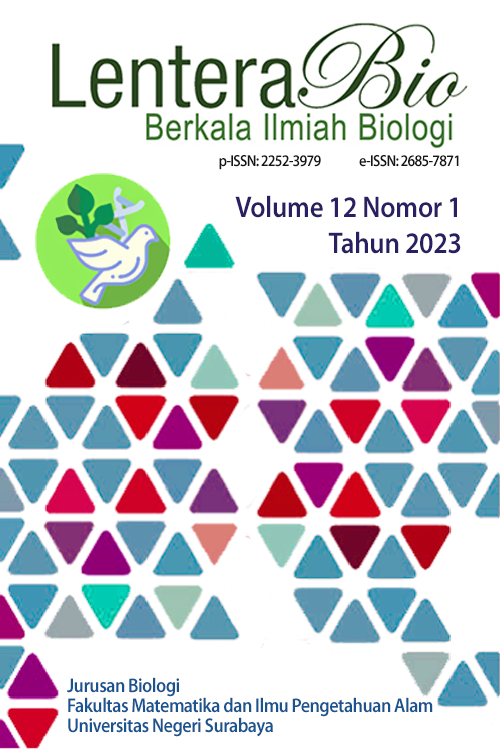Effect of Red Turi Leaf (Sesbania grandiflora L.) Extract on The Length of Ulcers and Leukocyte Count in Diabetic Mice
DOI:
https://doi.org/10.26740/lenterabio.v12n1.p70-81Keywords:
inflammation, alloxan, wound healing, hyperglicemia, ROSAbstract
Hyperglycemia in diabetes mellitus interferes with ulcer healing process and the body's immune response. Red turi leaf contains secondary metabolites with potential to promote healing of diabetic ulcers. The purpose of this study was to determine the effect of ethanolic extract of red turi leaf (Sesbania grandiflora L.) on ulcer length and leukocyte counts in alloxan-induced mice. This study was an experimental research using a completely randomized design (CRD) with 24 male mice which were divided into six treatment groups, negative control (KN), positive control (KP), Glibenclamid (GLB), DII (250 mg/kgBW), DII (400 mg/kg), DIII (500 mg/kgBW). Mice were induced diabetes melitus by injected alloxan 130 mg/kgBW intraperitoneally. Ethanolic extract of red turi leaf (Sesbania grandiflora L.) was administered orally for 14 days. Ulcer lengths were measured on the H1, H4, H6, H7, H10 and H14. Leukocytes were counted on the 15th day (after treatment). Data were analyzed statistically.. The results showed that red turi leaf extract had an effect on ulcer length (p<0,05) and leukocytes count (p<0,05). The optimal dose for diabetic ulcers was for DII (400 mg/kgBW) while the optimal dose for leukocyte count was for DI (250 mg/kgBW). Ethanolic extract of red turi leaves could be concluded to have potential for ulcer healing agent and able to maintains leukocytes count of diabetic mice.
Downloads
Published
How to Cite
Issue
Section
License
Copyright (c) 2023 LenteraBio : Berkala Ilmiah Biologi

This work is licensed under a Creative Commons Attribution-NonCommercial 4.0 International License.
Hak Cipta (c) LenteraBio: Berkala Ilmiah Biologi
Karya ini dilisensikan di bawah Lisensi Internasional Creative Commons Attribution-NonCommercial 4.0.
Pemberitahuan Hak Cipta.
Hak cipta dari artikel yang diterima untuk diterbitkan akan diberikan kepada jurnal sebagai penerbit jurnal. Hak cipta yang dimaksud meliputi hak untuk menerbitkan artikel dalam berbagai bentuk (termasuk cetak ulang). Jurnal mempertahankan hak penerbitan atas artikel yang diterbitkan.
 Abstract views: 649
,
Abstract views: 649
, PDF Downloads: 1232
PDF Downloads: 1232











